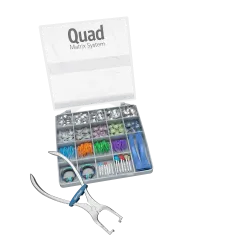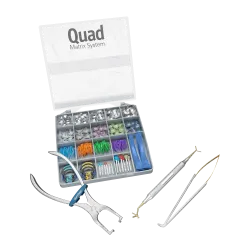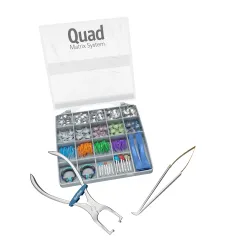
|

|

|
| Figure 1: Preop radiograph #2 mesial caries and #3 distal caries | Figure 2: Preop #2 | Figure 3: Preop #3 |

|

|

|
| Figure 4: Prepped #2 and #3 | Figure 5a & Figure 5b: Wedged and banded. Garrison® Firm Bands were selected to restore back-toback to retain shape and contour and allow for burnishing to confidently form a firm interproximal contact. A small split wedge was selected as the spacing between the teeth in the box was tight. The wedge was placed so that the tips of the split wedge slide on each side of the papilla to maintain contact with the band, creating stability and a tight seal in the box when the Quad Matrix Ring is placed. It is best to place the wedge from the side of the tooth with the smaller embrasure so the wedge opens into the larger embrasure space. Typically this is from the buccal on the maxilla. | |

|

|

|
| Figures 6a-c: The driver tip on the Quad Matrix Ring is marked with the black arrow and is placed between the split wedge, adapting the wedge to have an intimate contact with the band to create a perfect seal on the walls of the box. The niti ring helps to create pressure to separate the teeth slightly, which will ensure a firm interproximal contact after the restoration is placed. After one tooth is restored, the neighboring prepped tooth has the contact burnished and restorative material is placed. | ||

|

|

|
| Figure 7a & Figure 7b: These photos were taken immediately after the ring, wedge and bands were removed. Minimal flashing was left to minimize clean up and polishing, which also reduces the amount of tissue trauma for the patient | Figure 8: Post op of #2 and #3. After trimming and polishing and occlusion is adjusted, the contours on the buccal and lingual maintain ideal shape, marginal ridges have a nice natural roll to them due to the shape of the Garrison band. Interproximal contact is firm. | |




